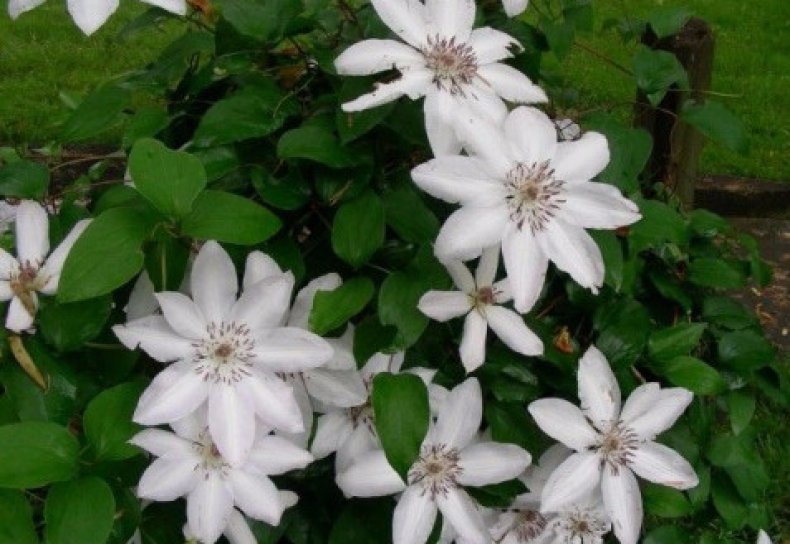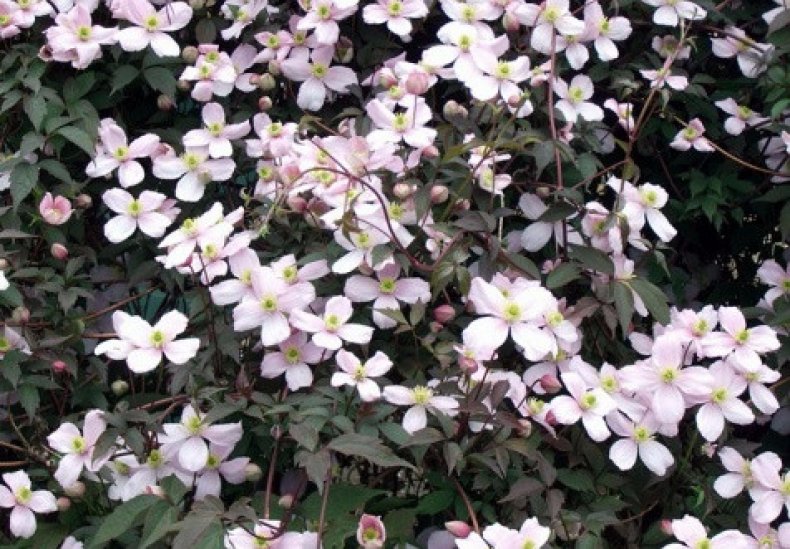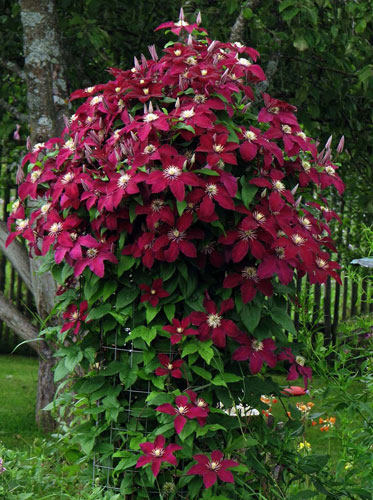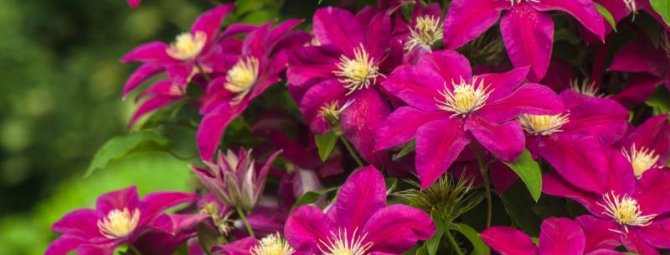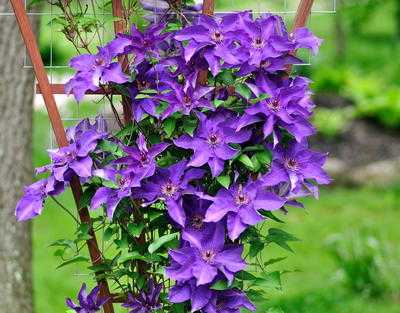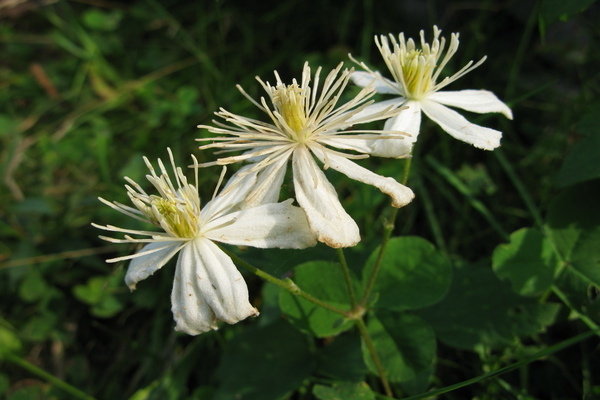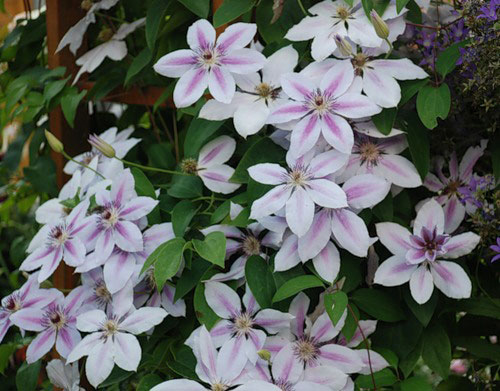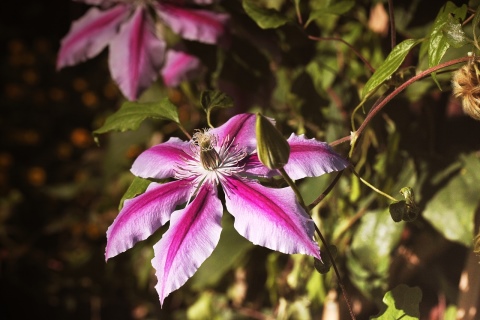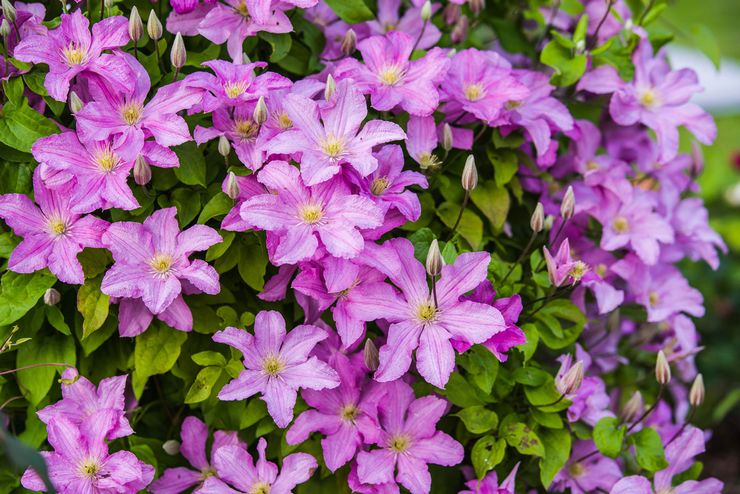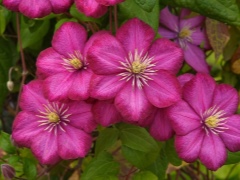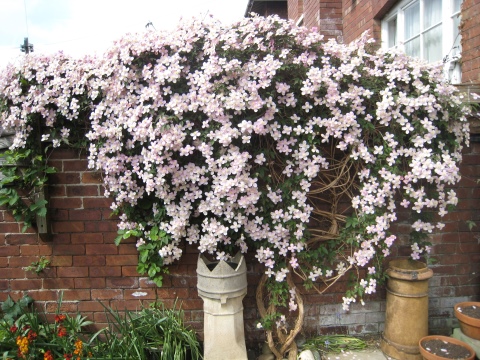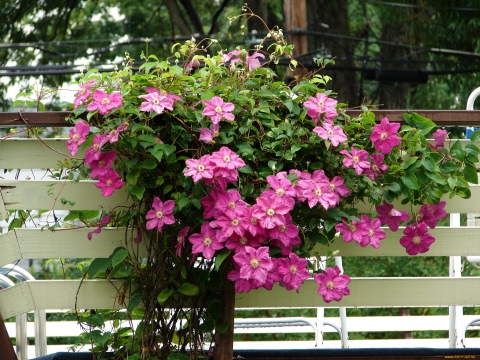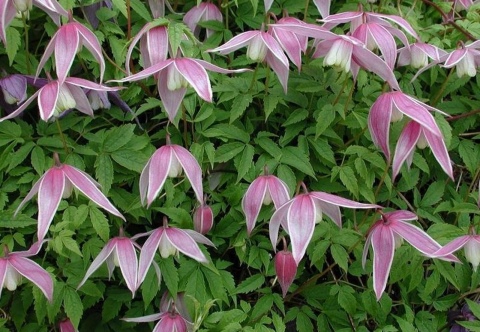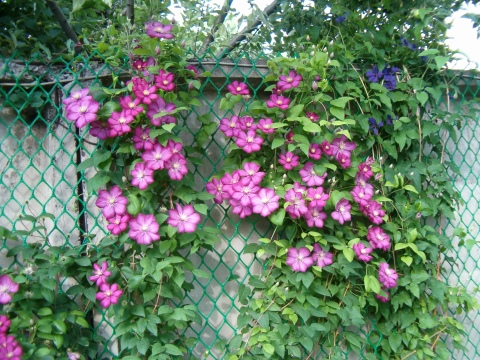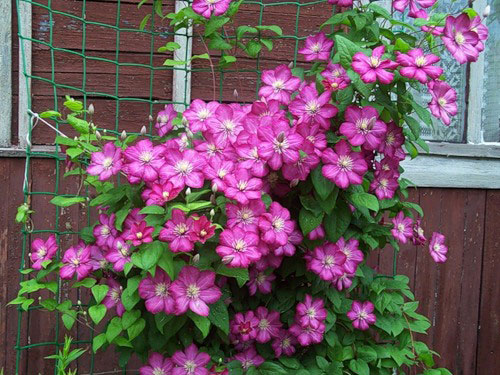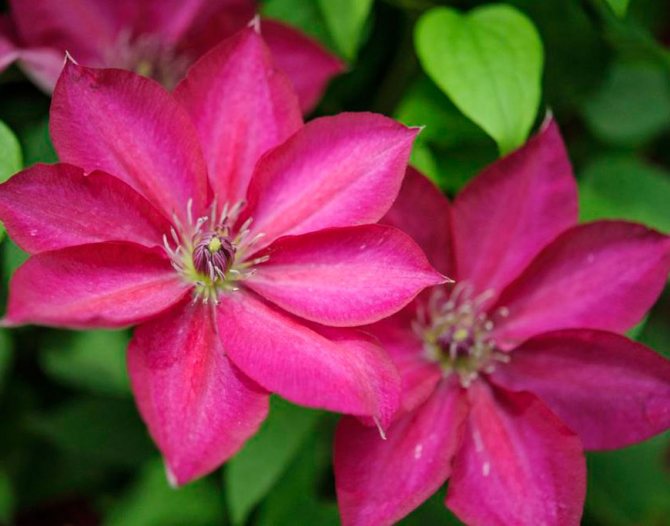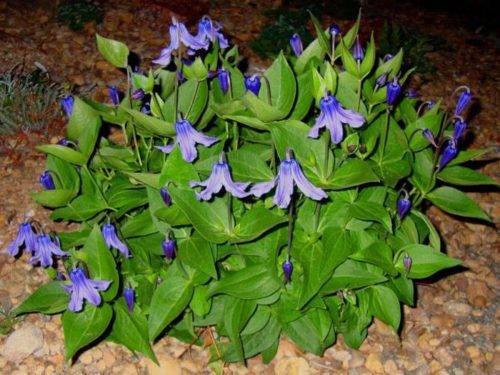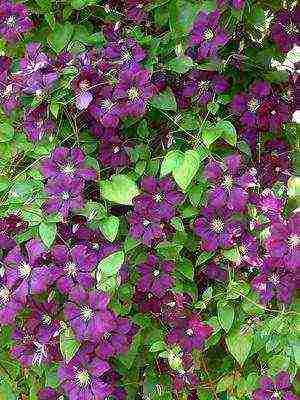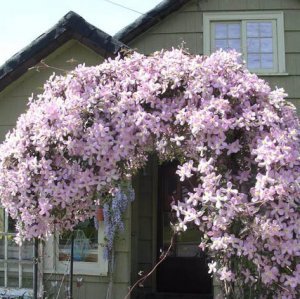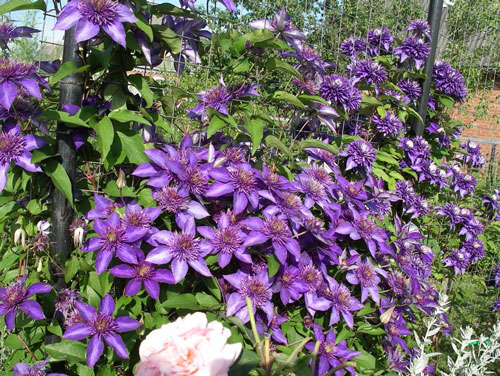What does the care of a perennial vine contain?
Proper planting and good maintenance will ensure that any plant grows well. Clematis must be watered at least twice every ten days - two buckets for each bush. You should also loosen the soil, remove weeds from the near-trunk area.
Pruning vine shoots plays an important role in its development. It is carried out using a pruner, garden shears.
There is sanitary pruning, which is carried out at random in time. It removes damaged, dried out branches and sun-burnt areas. Autumn - requires special attention, because it affects the appearance of clematis in the new season.
Special anti-aging pruning guarantees a lush, abundant and long-lasting flowering. It consists in removing branches that are more than three years old.
Gardeners with experience in such events use the three-tiered pruning method, regardless of which group clematis belongs to. Each tier should contain three to four shoots, and their length should be left as follows:
- in the first tier - up to 150 cm
- in the second - up to 100 cm
- in the third - three buds above the surface of the earth
All other shoots are removed.
Early flowering pleases the shoots of the first tier, then the second, then the shortest ones. But clematis blooms all summer. To increase the size of the flowers and the bush does not become thick, the shoots that have finished flowering should be cut off fifty centimeters. This procedure can be carried out until August, but not later. Liana needs to gain strength to survive the cold months.
During the period of bud formation, clematis can be fed. It responds well to special flower mixes.
Diseases and pests
Clematis, like other garden plants, suffer from various diseases and pests. Most often, the bushes die from wilting caused by the death of the root system from pathogenic fungi. For prophylaxis in early spring and autumn, it is necessary to water clematis under the root with a solution of "Fundazol".
With high humidity and thickened planting, vines can suffer from gray rot. For prophylactic purposes against this disease, "Fundazol" is also used in a proportion of 0.2%.
Clematis is sometimes affected by powdery mildew and rust. In the fight against diseases, the following drugs help:
- "Topaz";
- "Hom";
- Fundazol;
- Fitosporin;
- "Azocene".
Processing should be carried out at the first signs of damage. In addition, you can use green soap for prevention and treatment (300 g per bucket of water). Leaves and stems are sprayed thoroughly from all sides, early in the morning in dry and calm weather.
The pests of clematis Mazovsha include spider mites, aphids, and gall nematodes. The nematode is especially dangerous and difficult to remove; toxic nematicides are used to combat it. If the plant cannot be saved, it is dug up and burned. Fitoverm, which is safe for human health, helps against spider mites and aphids.
What varieties and types belong to group 3
Most of the varieties of clematis found in gardens belong to the 3rd group of pruning. These are branched vines with long (4-6 m) shoots and a strong root system.
Zhakman's group. Quite large plants, reaching a height of 2-4 m, depending on the variety. In a sunny place, the liana does not grow as long as in partial shade, but the flowering is much more abundant. The leaves of Zhakman's clematis are complex, of 3-5 leaves. The flowers fully open, they can be of different shades. Large in size - from 8 to 20 cm in diameter.
Clematis Jacqueman
The varieties belonging to this group form buds only on new shoots of the current year. At the end of autumn, they are severely pruned. Popular varieties of this group:
- Clematis Bella - has short shoots (up to 2 m) and white star-shaped flowers. Its flowering period is from July to September. Very winter-hardy.
- Rouge Cardinal - the length of the shoots is the same as that of the previous variety. The petals of the cruciform purple flowers. Blooms in the middle of summer. It is better to cover for the winter.
- Gipsy Queen is a liana up to 3.5 m, forming a massive bush. Bright purple petals practically do not fade in the sun.
Viticella group - represented by varieties with purple flowers of varying color intensity. They can be either open or drooping. The diameter of the flowers is 10-20 cm. The shoots of this group grow very quickly and reach a length of 3-3.5 m. Some varieties of the group:
Viola - the height of the bush reaches 2.5 m. The flowers are open. Their color is dark purple with lilac streaks.
Clematis Viticella
Ville de Lyon - shoots up to 3.5 m long. Carmine-red petals fade in the sun. Long-lasting and abundant flowering. Up to 15 buds can form on each shoot.
Advice. For clematis, it is better to use a vertical mesh as a support. So they will look like a living wall, strewn with flowers on both sides.
Integrifolia group. This species is not able to cling to the support itself. The height of the bushes is about 2.5 m. The flowers are drooping, they look like bells and a variety of colors. Clematis Durana is considered one of the most beautiful in this group. A fast growing shrub with simple, ovoid leaves. Flowers, most often consisting of 4 petals, open, drooping, medium-sized. The color of the petals is deep purple, the anthers are yellow.
Clematis Integrifolia
The Tangutic group is a very tall, 3-4 m liana, covered with orange-yellow, small (3-10 cm in diameter) drooping flowers that look like physalis. Prefers bright lighting. Blooms from June to September.
Clematis Tanguica
The Texensis group is one of the most beautiful clematis. The flowers, consisting of 4 petals, have the shape of a jug and do not fully open. The color scheme is red, pink, purple.
Clematis Texensis
Eastern clematis is a very long liana (4-6 m). In July-August it is covered with yellow, pubescent flowers consisting of 4 petals. Shaggy, decorative fruits in autumn become a wonderful decoration of the garden.
Eastern clematis
The best varieties of clematis for the Moscow region
Clematis for the Moscow region should be selected very carefully. The following are zoned varieties clematis for the Moscow region... Suitable for cultivation in our climate are alpine (C. alpina), large-petal (C. macropetala), Siberian (C. sibirica), which is considered by some botanists as a variety of alpine species, and Okhotsk (S. ochotensis). These are shrubby lianas with woody stems, blooming in May-June with single drooping broad-bell-shaped flowers. Individual flowers often appear throughout the summer. Plants are winter-hardy, they are actively selected in Canada. Growing conditions are the same as for other clematis. They do not require annual pruning, only sanitary pruning and thinning of shoots in adult bushes are carried out. They clearly deserve more distribution in our gardens, because their "floating" flowers are very delicate and graceful.
The best varieties of clematis for the Moscow region include the following cultivars:


"Lemon Dream" ("Lemon Dream") - a variety that stands out with a light lemon-yellow color of flowers, which, however, fade. It has terry bell-shaped flowers, uncharacteristically large for princes, which have a weak grapefruit aroma. Plant height 2-3 m.
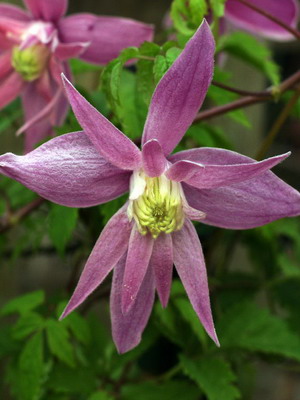
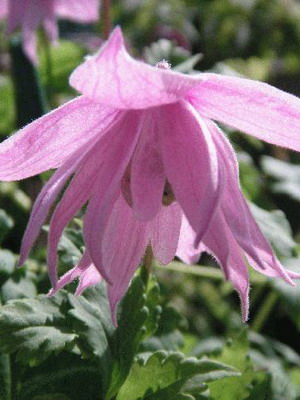
Clematis "Markham's Pink" ("Markham's Pink") blooms profusely with beautiful semi-double raspberry pink flowers. Liana up to 2.5 m high.
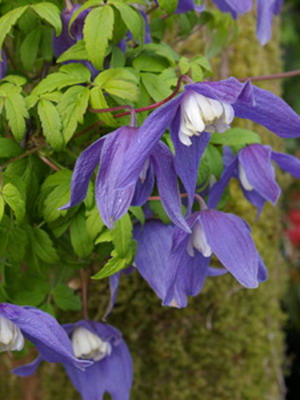

"Maidwell Hall" ("Maidwell Hall") - these are the best clematis for the Moscow region, bloom profusely with semi-double violet-blue bell flowers. The plant reaches a height of 2-2.5 m.
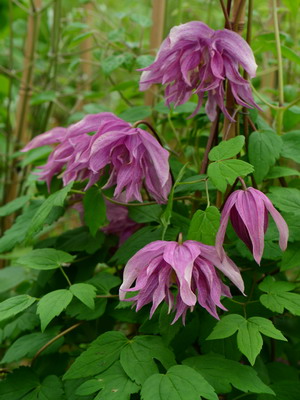
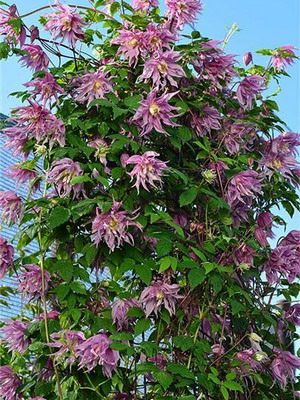
"Purple Dream" ("Purple Dream") - a variety with large double pink-purple bell-shaped flowers with swirling "sharp" sepals that slightly smell of grapefruit. The plant is 2-3m high.
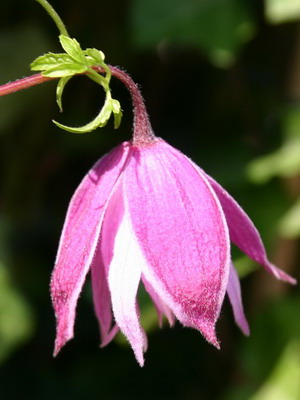

Clematis "Rosie O'Grady" ("Rosie O'Grandy") blooms profusely pink drooping "bells". Liana 2-3 m high.

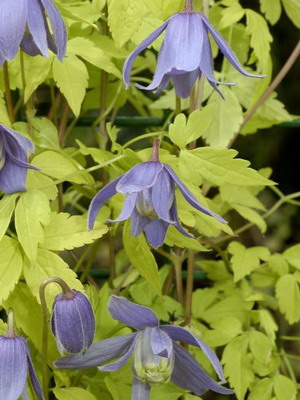
"Stolwijk Gold" ("Stolwijk Gold") - the first variety with golden yellow leaves, which contrast with violet-blue bell-shaped flowers. Plant height 2-2.5 m.
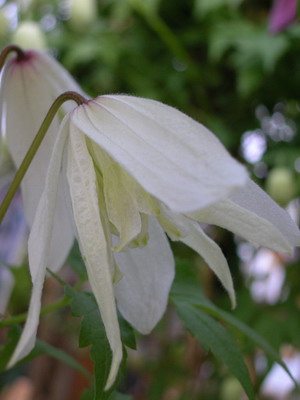

Clematis "White Swan" blooms profusely with white, semi-double, drooping flowers. Liana reaches a height of 2-3 m.
What do you need to know when planting a beautiful creeper?
You should not be afraid to plant such a perennial. Its cultivation is not difficult, just when planting, you need to take into account some features:
- he is a fast-growing vine, which adds fifteen centimeters to the shoot in a day
- its comfortable place is sunny, calm
- the soil should be drainage with plenty of organic matter
- the flower drinks water well, but does not like its stagnation
- the ground must be permeable
- due to the lack of a long root system, it is better to cover it for wintering
- he has a positive attitude towards feeding
- you need to retreat 70 cm from the wall of the house or fence
- when planting, the roots should be spread out
- a distance of one and a half meters is maintained between several bushes
- lattice, pergola, trellis are installed from east to west
- if the roots dry up when buying, it is better to lower the bush into water so that it collects a sufficient amount of moisture for itself
- the hole should be made according to the size of the bush, for a large one it should be 70x70 cm and at least 70 cm deep for good root development
- when buying, it is worth considering the climatic zones
If such a list does not scare you, then in the near future clematis will delight you with abundant flowering and decorate your site.
3 groups of clematis pruning
According to the type of care, the plants are divided into 3 groups of clematis pruning. The first type of pruning includes clematis, which are not pruned. To the second - clematis, in which, after the first flowering, last year's faded shoots are cut out, and before winter the shoots of the current year are cut to the first leaf or shortened by about a quarter. The third type includes species and varieties in which the shoots are cut off completely or left 15-20 cm above the soil level. This type also includes clematis with herbaceous shoots dying off before winter, which are removed.
So, Zhakman's clematis and violet belong to the third pruning group, and woolly, spreading and flowering clematis belong to the second group. Clematis straight (C. recta) is a herbaceous perennial, and before winter its dying shoots are removed. This is how the main groups of clematis are formed, which can be grown on your site.
Varieties for Siberia
When choosing clematis of 3 groups, the best varieties in Siberia, you can pay attention to most of the vines suitable for growing in the Urals. Even late flowering plants adapt well in cold climates.
The buds bloom in late July - early September. Such vines bloom once, but abundantly. When the bush fades, the shoots are immediately cut off, leaving 1-2 buds, and the rhizome is covered for the winter.
For Siberia, you can choose the following varieties:
- Zhakman. Vines throw out beautiful purple flowers. The petals are velvety. The diameter of the flower is about 8 cm. The scourge grows up to 3.5 m long. The bush is abundantly covered with color from July and fades in September.
Handsome Rouge Cardinal mesmerizes with red flowers with a raspberry hue. The stamens are white, often with an admixture of pink. Scourges grow up to 2 m long. Flowers about 10 cm in diameter appear moderately on the bush from the beginning of July and fade in September.
The Huldin variety from early August to mid-September pleases with white flowers up to 8 cm in diameter. Sometimes the petals acquire a lilac hue. Scourges grow up to 4 m long.
Hagley Hybrid is distinguished by its original pink color. The tops of the stamens are colored with a burning red tint.Large flowers up to 16 cm in diameter appear in July, and in August the bush fades. The length of the lashes reaches 3 m.
The Ville de Lyon variety will appeal to lovers of everything bright. From July to September, the bush is abundantly covered with flowers 12 cm in diameter with red petals and yellow stamens. Intensively growing lashes stretch up to 4 m in length.
Almost all varieties of clematis of the 3rd group are suitable for growing in Siberia. For the winter, the plants need to be well covered and do not forget to cut them.
Clematis varieties by flower size
Clematis varieties differ in a huge number of varieties. There are many vines with small flowers, similar to bells, with double and huge (up to 20 cm) beautiful daisies. Almost everything is presented in these vines - from delicate white and sky blue to bright red, purple and violet.
The most famous varieties in Russia are presented in the table. They are served according to the size of the flower, with a short characteristic of the variety.
| Category | Variety name | a brief description of | Peculiarities |
| Large-flowered varieties | Akash | The flowers are purple-purple, with a characteristic red stripe in the center, 12 to 20 cm in diameter | The height of the creeper is 2 meters, the cutting group is the 1st, in partial shade the flowers do not lose their color brightness |
| Beauty Bride | White flowers with slightly wavy edges up to 28 cm, liana height up to 3 m | Does not grow in the wind and bright sun, cut group 2 | |
| Vistula | Light blue or light purple flowers up to 20 cm with yellow stamens | Vine height up to 3 m, trim group 3rd | |
| Mazovshe | Burgundy velvety flowers 15-20 cm in diameter with showy yellow stamens | Shoot height up to 3.5 m, cutting group 2 | |
| Nelly Moser | Light purple or light pink petals have a bright red stripe in the center and red stamens, flower diameter 14-16 cm | The plant does not like the bright sun, pruning group 2 | |
| Medium-sized flowers | Maria Sklodowska-Curie | White feathering large flowers acquire a greenish tint in cold weather. Diameter 12-16 cm | Shoot height up to 2 m, cutting group 1st |
| Little Maimand | Has an unusual salmon-pink color of petals, their diameter is up to 12 cm, the stamens are yellow | Plant height up to 2.5 m, you need to trim twice | |
| Queen Jadwiga | Silky white petals slightly curved outward, have a rib in the center, purple stamens | The plant grows well in partial shade, height up to 2.5 m, pruning group 2 | |
| Copernicus | Bright blue semi-double flowers up to 12 cm in diameter, yellow stamens | Cutting group 2, plant height up to 2 m | |
| Viva Polonia | Bright red flowers with sharp edges have a white-yellow center, dark red stamens | Cutting group 2, liana height up to 2.5 m | |
| Small bell flowers | Arabella | Bluish-purple flowers up to 8 cm in diameter | The height of the vines does not exceed 2 m, the plant does not cling to the support, it spreads well along the ground, the third pruning group |
| Wahlenburg | Red-purple flowers up to 7 cm in diameter have a white vein and a white core in the center of the petals | Creeper height up to 3.5 meters, trim group 3rd | |
| Alyonushka | Delicate pink bells up to 7 cm in diameter | Plant up to 1.8 m, planted next to roses and in containers, unpretentious | |
| Blue Explosion | Has blue double flowers with slightly pink edges | Plant height up to 3 m, cut group 2 | |
| Bill McKenzie | Yellow bells, up to 8 cm in diameter | The height of the plant reaches 5 m, it has beautiful seedlings, the plants are drought-resistant and unpretentious, the 2nd pruning group | |
| Ballet Skirtt | Semi-double pink bells up to 9 cm | The plant is unpretentious, the height of the liana is up to 2 m, the group of pruning is the 2nd |
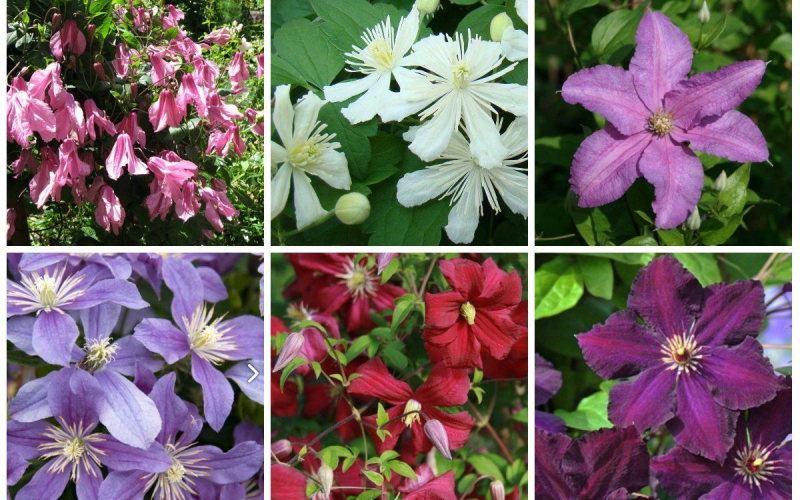
Clematis Wallenburg

